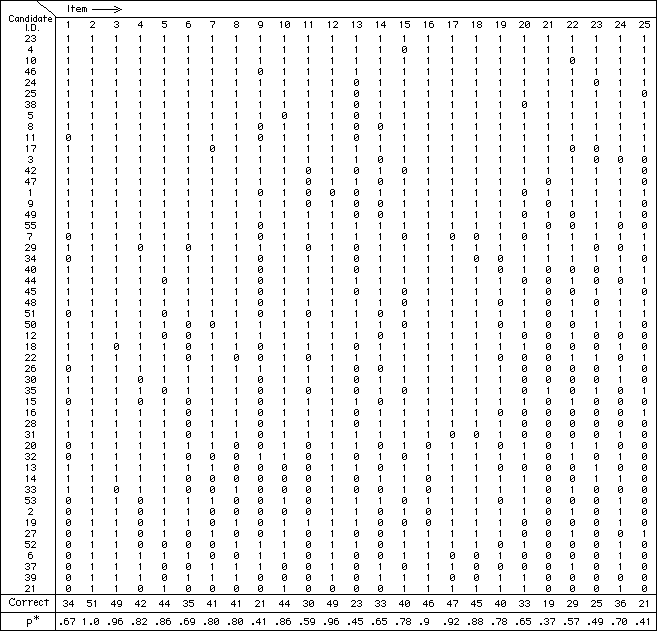So what are we listening for? A comparison of the English listening constructs
in the Japanese National Centre Test and TOEFL® iBT
Appendix B: Raw data and descriptive statistics
for the 2006 J-NCT examinees used in this study

Table adapted from Henning (1987)
NOTE: "1" indicates a correct response and "O" an incorrect response.
*Items should be rejected if the proportion correct is < .33 or p> .67 (Henning, 1987 citing Tuckman, 1978)
[ p. 88 ]
| Item Number | Sum for High Group (n=14) |
Sum for Low Group (n=14) |
Discrimination Index |
| 1 | 13 | 3 | .81 |
| 2 | 14 | 14 | .50 |
| 3 | 14 | 13 | .51 |
| 4 | 14 | 8 | .64 |
| 5 | 14 | 11 | .56 |
| 6 | 14 | 7 | .67 |
| 7 | 14 | 6 | .68 |
| 8 | 14 | 5 | .73 |
| 9 | 14 | 4 | .73 |
| 10 | 14 | 8 | .61 |
| 11 | 12 | 1 | .92 |
| 12 | 14 | 13 | .51 |
| 13 | 7 | 6 | .54 |
| 14 | 11 | 5 | .69 |
| 15 | 12 | 10 | .55 |
| 16 | 14 | 9 | .60 |
| 17 | 14 | 12 | .54 |
| 18 | 14 | 11 | .56 |
| 19 | 14 | 9 | .60 |
| 20 | 14 | 9 | .60 |
| 21 | 13 | 0 | 1.0 |
| 22 | 12 | 6 | .67 |
| 23 | 11 | 3 | .79 |
| 24 | 13 | 9 | .59 |
| 25 | 10 | 1 | .90 |
Discrimination indices for the 2006 English Listening Section of the
Japanese National Centre Test when administered to a group of 51 high school students
NOTE: The upper and lower 28% of the total group was used in this study, as recommended by Henning (1987).
According to the discriminability continuum, the acceptable range starts 2/3 of the way along.
Hence if the discrimination index is below .67, the item should be rejected (Henning, 1987).
| Main Article | Appendix A | Appendix B | Appendix C | Appendix D | Appendix E |
| Appendix F | Appendix G | Appendix H | Appendix I | Appendix J | Appendix K |
2006 Pan SIG-Proceedings:
Complete Pan SIG-Proceedings: